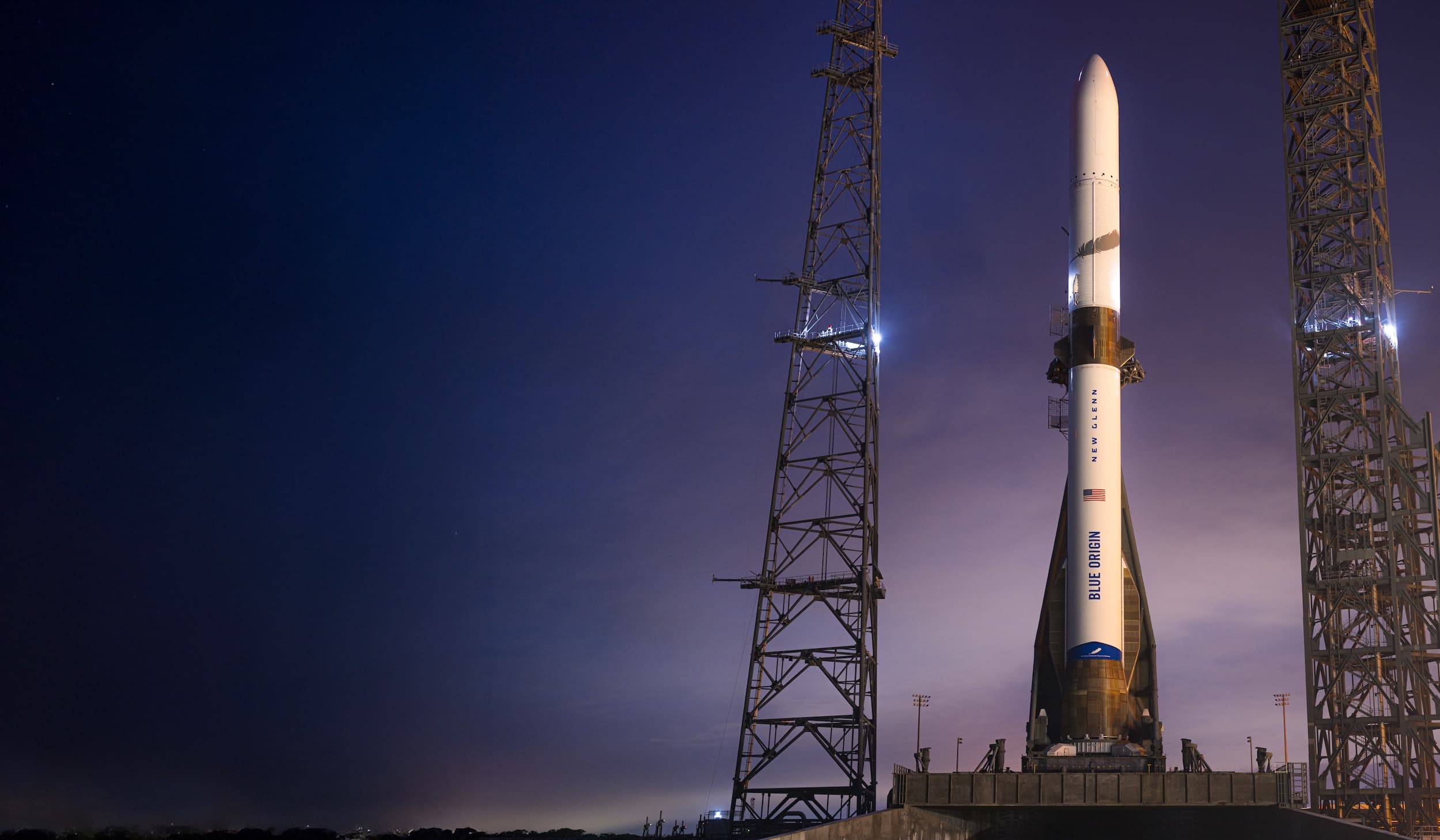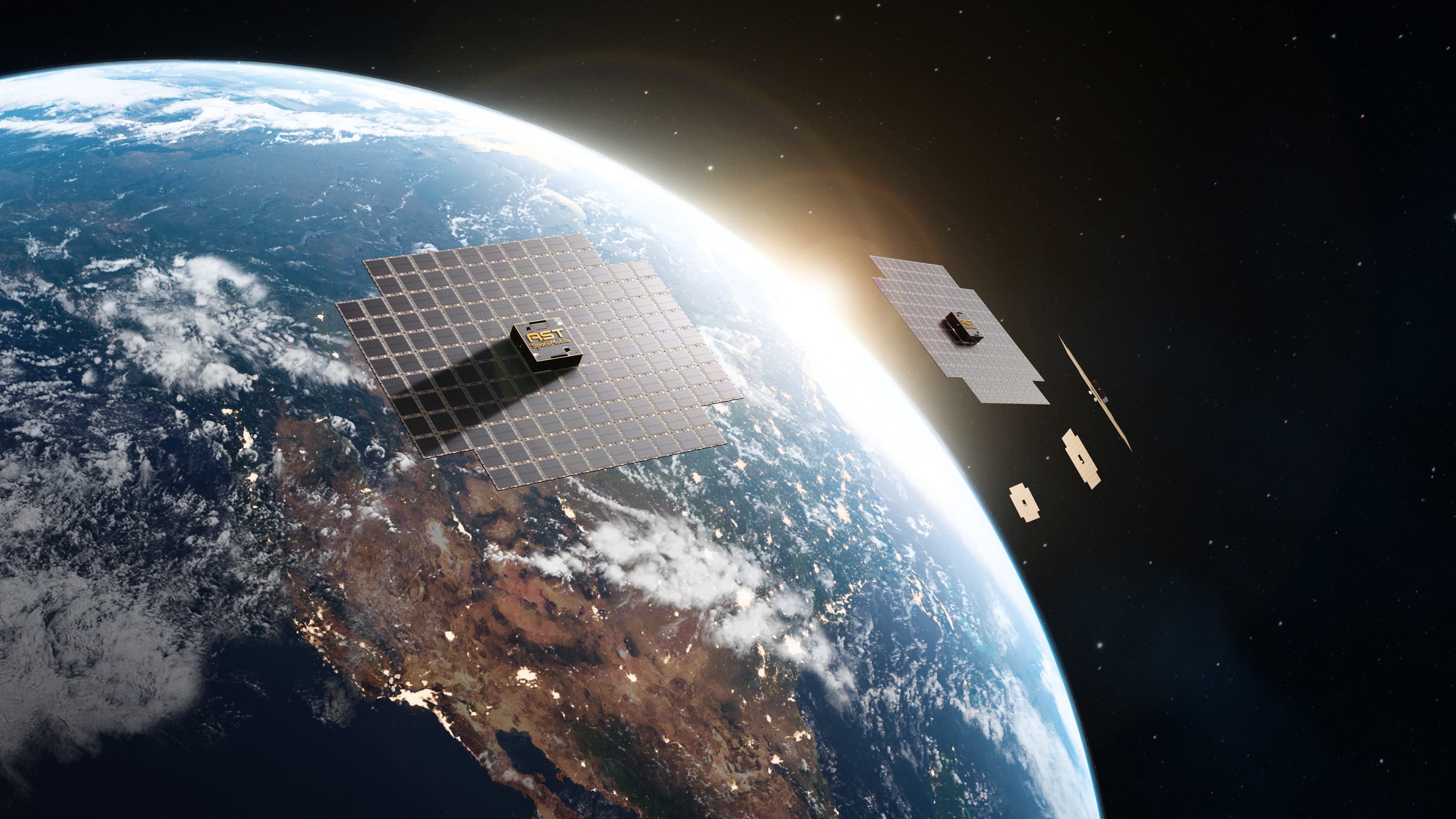New Glenn
The Foundation for a New Era

New Glenn is our giant, reusable rocket built for bigger things.
Latest Flight
NG-1

Reusable for Affordability and Availability

New Glenn's first stage is designed for a minimum of 25 flights. By operating like a commercial airliner (but with cleaner fuel), New Glenn will lead to significantly less waste and cost.
Twice the Volume

Seven meters. With twice the volume of smaller, five-meter class payload fairings, customers have more flexibility to package their payload in new ways.
Single Configuration for Maximum Flexibility and Savings

New Glenn is designed to accommodate a variety of payloads and destinations to meet the broadest range of customer needs, and significantly reduce cost per launch.
Liquid Hydrogen-Powered Upper Stage Optimized for Performance

New Glenn will launch payloads into high-energy orbits. It can carry more than 13 metric tons to geostationary transfer orbit (GTO) and 45 metric tons to low Earth orbit (LEO).
First Step Toward Our Vision

New Glenn is named after John Glenn, the first American to orbit Earth. The rocket is engineered with the safety and redundancy required to fly humans, and will enable our vision of building a road to space for the benefit of Earth.
Trusted by the World's Civil, National Security, and Commercial Leaders
See the range of partners already committed to New Glenn. We're proud to support their critical missions.

Project Kuiper
Amazon's Project Kuiper will fly advanced satellites to deliver high-speed, low-latency broadband service globally.

NASA
ESCAPADE is a dual spacecraft mission to study solar wind energy on Mars.

AST SpaceMobile
AST SpaceMobile is building the first and only space-based cellular broadband network designed for both commercial and government applications.
High-Performing,American-MadeEngines

Reusable First Stage Powered by Seven BE-4 Engines

Powerful
The vehicle is powered by seven of the most powerful liquid oxygen (LOX) / liquefied natural gas (LNG)-fueled oxygen-rich staged combustion engines ever flown. Each BE-4 engine is reusable and generates 550,000 lbf (2,450 kN) thrust at sea level with deep-throttle capability.
Proven
Two BE-4 engines drive the first stage of United Launch Alliance’s Vulcan vehicle.
Efficient Propellants
LNG is higher-performing and cleaner-burning than most traditional kerosene-burning engines, thereby improving engine reusability and requiring less total fuel for the same performance.
American-Made
Full-rate production at Blue Origin’s manufacturing facilities in Kent, WA and Huntsville, AL ends America’s reliance on Russian rocket engine technology.
Two Restartable BE-3Us Power the Second Stage

High-Performing
Each of the two BE-3U engines generates 173,000 lbf (770 kN) of vacuum thrust. Coupled with higher thrust and performance, the engine’s in-space restart capabilities promote versatility for New Glenn’s second stage.
Pedigree
Leverages more than a decade of operational experience with liquid oxygen/liquid hydrogen cryogenic rocket engines, including dozens of successful New Shepard launches flown with the BE-3PM engine.
American-Made
Assembled at Blue Origin's engines manufacturing facility in Huntsville, AL.
Mission Agnostic
Optimized to operate in the vacuum of space and meet the diverse demands of our customers, including direct payload injection to high-energy orbits.
A Giant Among Rockets

At more than 320 ft (98 m) tall, New Glenn is one of the largest vehicles ever built.

Seven-Meter Fairing
Twice the volume of traditional five-meter class fairings means room for bigger constellations and larger payloads.
Upper Stage
Hydrogen-powered upper stage designed for demanding, highly energetic missions to low Earth orbit (LEO), medium Earth orbit (MEO), and geosynchronous orbit (GEO).
BE-3U
Built on New Shepard’s BE-3PM flight heritage, the BE-3U is optimized to operate in the vacuum of space. Its high thrust and high specific impulse enable New Glenn’s upper stage to accomplish a wide variety of missions.
Fins
Four actuated aerodynamic control surfaces for attitude adjustment during the first stage’s descent and landing.
Reusable First Stage
Designed for reuse and minimal maintenance in between flights.
Strakes
Wing-like to provide lift and cross-range for the reusable first stage during its descent back to Earth.
Landing Gear
Aft module houses six hydraulically-actuated legs to support and secure the first stage during landing on a moving platform.
Welcome to the Florida Space Coast

Launched and Refurbished in Cape Canaveral

New Glenn is built, integrated, launched, refurbished, and re-flown within a nine-mile (14 km) radius of the rocket factory. Located in Exploration Park just outside the gates of Kennedy Space Center, the process starts at Blue Origin's state-of-the-art manufacturing complex, which houses the vehicle's fabrication, integration, and operations facilities, as well as New Glenn Mission Control.
The New Glenn Launch Complex

Launch Complex 36 (LC-36) is located at Cape Canaveral Space Force Station just nine miles (14 km) away from the rocket factory. Blue Origin invested more than $1 billion to rebuild the launch site from the ground up. Completed in 2021, LC-36 is the first newly rebuilt launch complex since the 1960s.
The complex is home to New Glenn’s launch pad, vehicle integration, first stage refurbishment, propellant facilities, and environmental control center. LC-36 is the former home of more than 140 Atlas II/III launches, including the Mariner, Pioneer, and Surveyor missions.
A New Glenn Orbital Flight
New Glenn lifts off. Following separation, the first stage autonomously descends to a landing platform located 620 miles (1,000 km) downrange. The two BE-3Us ignite, propelling the second stage into space. The fairing separates, safely delivering the payloads into orbit.

Built by the Best People in Aerospace
New Glenn is built by a diverse, world-class team proud to make progress toward a multi-generational vision of millions of people living and working in space for the benefit of Earth.

Fly New Glenn
Tell us about your payload needs or request a payload user's guide.


